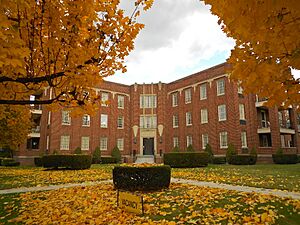East York, Pennsylvania facts for kids
Quick facts for kids
East York
|
|
|---|---|

House on Manheim Street
|
|

Location in York County and the U.S. state of Pennsylvania.
|
|
| Country | United States |
| State | Pennsylvania |
| County | York |
| Township | Springettsbury |
| Area | |
| • Total | 2.78 sq mi (7.20 km2) |
| • Land | 2.78 sq mi (7.20 km2) |
| • Water | 0.00 sq mi (0.00 km2) |
| Elevation | 449 ft (137 m) |
| Population
(2020)
|
|
| • Total | 9,555 |
| • Density | 3,439.52/sq mi (1,327.99/km2) |
| Time zone | UTC-5 (Eastern (EST)) |
| • Summer (DST) | UTC-4 (EDT) |
| ZIP code |
17402
|
| Area code(s) | 717 |
| FIPS code | 42-22104 |
| GNIS feature ID | 2389452 |
East York is a community in York County, Pennsylvania, United States. It's known as a "census-designated place" (CDP). This means it's an area that the government counts for population statistics. In 2020, about 9,555 people lived there.
Contents
Exploring East York's Location
East York is found within Springettsbury Township. It sits just east of the main city of York.
The United States Census Bureau says that East York covers an area of about 2.9 square miles (7.2 square kilometers). All of this area is land.
East York's Past: A Look at Its History
East York began to be developed as a suburb in 1903. People at the time believed that more industries would come, bringing many new residents. John H. Longstreet had a vision for how the area would grow.
Soon, many beautiful homes were built. More building lots were ready for new owners to create their own houses.
Early Development and Features
The East York area was often called the "Keesey Tract." It stretched for about two-thirds of a mile along both sides of Market Street. This street was York's main road and part of the famous Lincoln Highway.
It was only an eleven-minute ride from Center Square in York. The area was on high ground, which helped with natural drainage. It had modern features like cement sidewalks and curbs. The streets were paved with macadam, a type of road surface. Residents also had clean, filtered water, electric lights, and a full sewer system.
Transportation and Community Life
The York Railways Company had train lines running along Market Street. These lines went through the center of East York and connected to nearby towns. You could ride the entire length of Market Street for just one train fare.
East York also offered its residents the benefits of an up-to-date club. Anyone living there could become a member. They could enjoy dining services, games, and lawn tennis. The club also offered many social events. These benefits were open to members' families too.
Many important people lived on East Market Street and nearby. These included George L. Stallman, Charles E. Tucker, and Mahlon Haines. Other notable residents were Congressman E.S. Brooks and Professor C.B. Heinly.
The East York Historic District is a special area. It is listed on the National Register of Historic Places because of its historical importance.
Hiestand School: A Place for Learning
In 1912, the John S. Hiestand School was built in East York. The land for the school was given by John S. Longstreet. This school was part of the Independent School District at the time.
It was a "graded school," meaning it had different levels for students. A forward-thinking Board of Directors managed the school. Students were taught by skilled teachers from first to eighth grade. The school prepared them to enter York High School.
The Independent School District paid for students' tuition at York High School. This was part of an agreement with the city school board.
When the school was designed, the main focus was the children's well-being. The building was placed in the middle of large playgrounds. It had two classrooms, separate cloakrooms for boys and girls, and working toilets. There were also big basement playrooms for bad weather. The school also had a public library. All students and residents could use its well-chosen books for free.
The original two classrooms were doubled to four in 1927. By 1937, the school had six rooms. The Hiestand School closed in June 1978. This was due to money reasons and fewer students. Since then, different community groups have used the building.
East York's Population: Demographics
| Historical population | |||
|---|---|---|---|
| Census | Pop. | %± | |
| 2020 | 9,555 | — | |
| U.S. Decennial Census | |||
In 2000, about 8,782 people lived in East York. There were 3,726 households and 2,455 families. The population density was about 3,032 people per square mile (1,171 people per square kilometer).
About 23.8% of households had children under 18 living with them. Many households (56.4%) were married couples living together. About 29.6% of all households were made up of individuals living alone. Of these, 15.5% were people aged 65 or older.
The average household size was 2.24 people. The average family size was 2.77 people.
The population was spread out by age:
- 18.8% were under 18 years old.
- 5.4% were from 18 to 24 years old.
- 24.4% were from 25 to 44 years old.
- 23.9% were from 45 to 64 years old.
- 27.5% were 65 years or older.
The median age in East York was 46 years. For every 100 females, there were about 85.8 males.
The median income for a household was $48,689. For a family, the median income was $57,461. About 3.1% of the population lived below the poverty line. This included 0.4% of those under 18 and 4.9% of those 65 or older.
See also
 In Spanish: East York (Pensilvania) para niños
In Spanish: East York (Pensilvania) para niños



